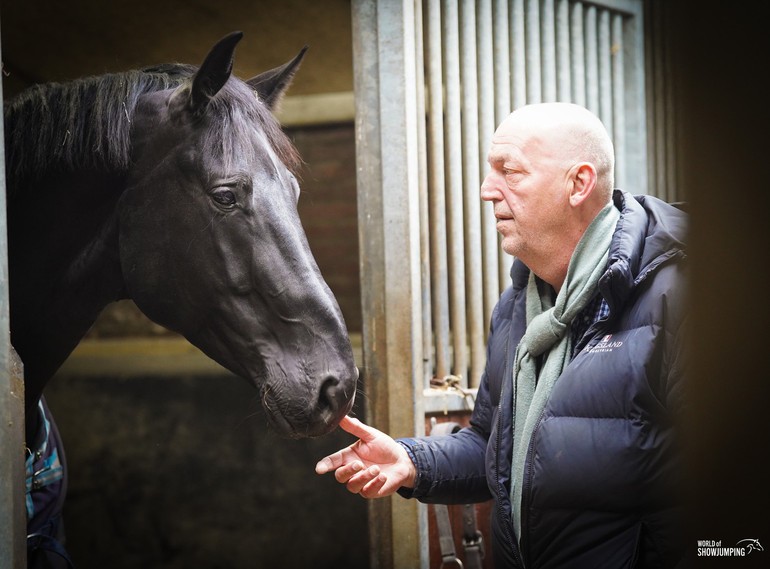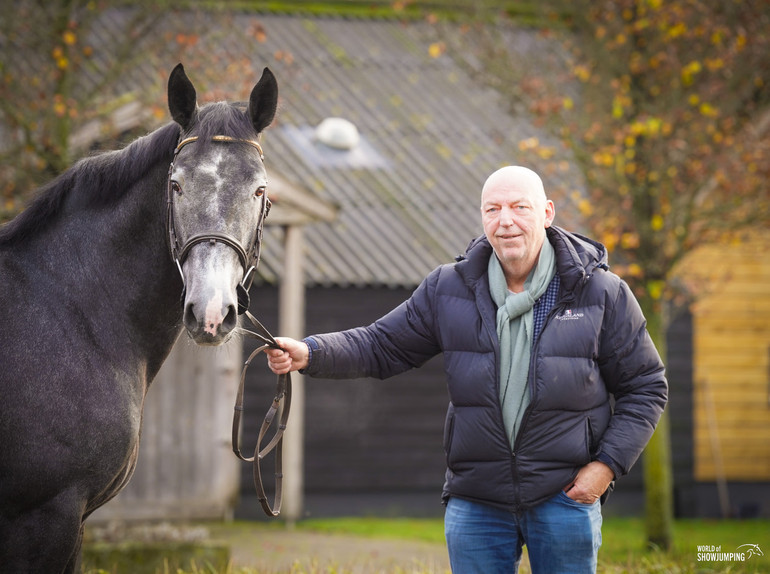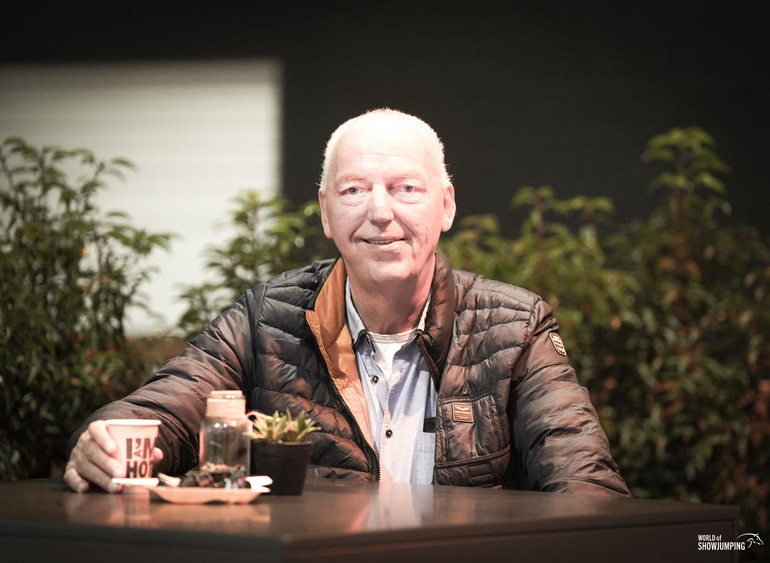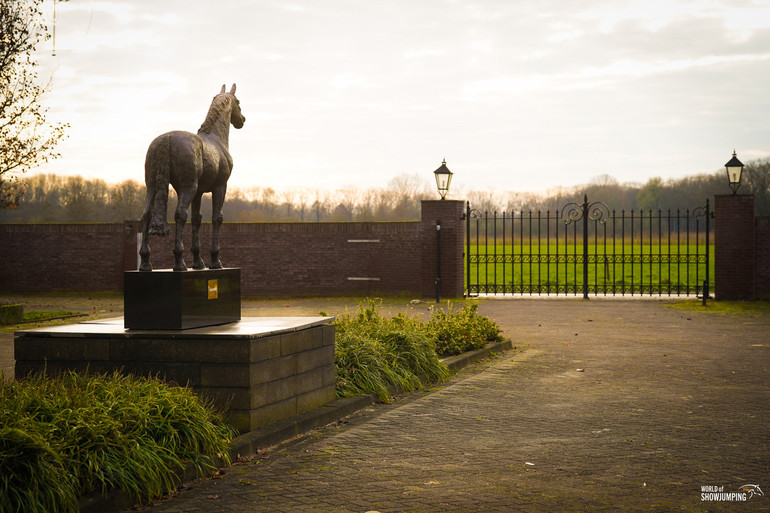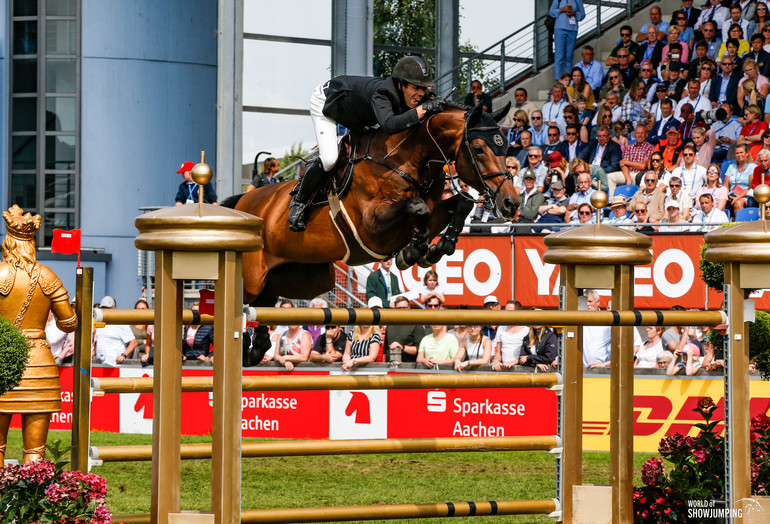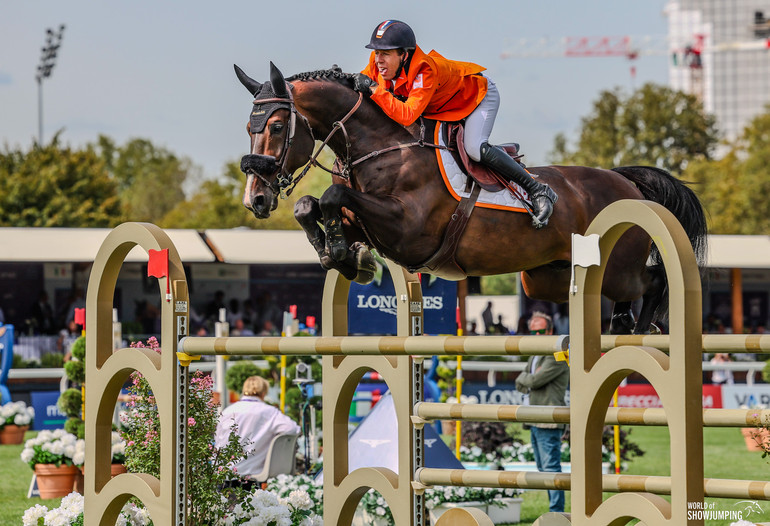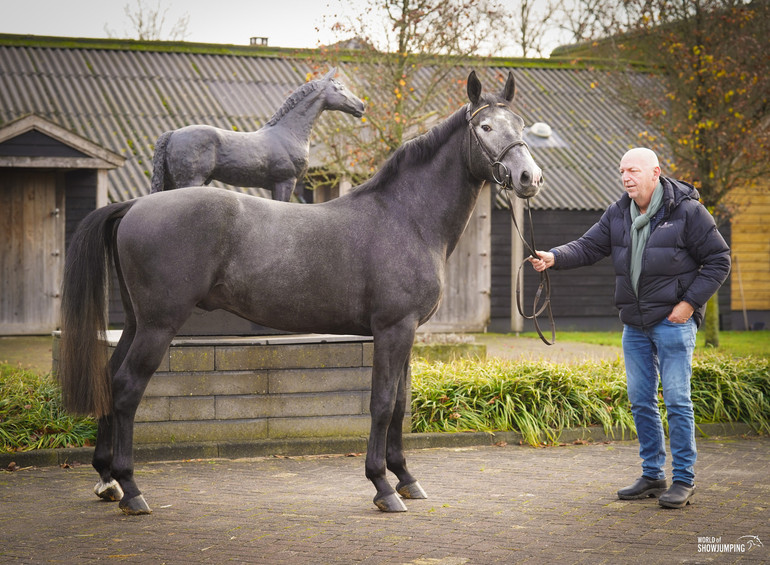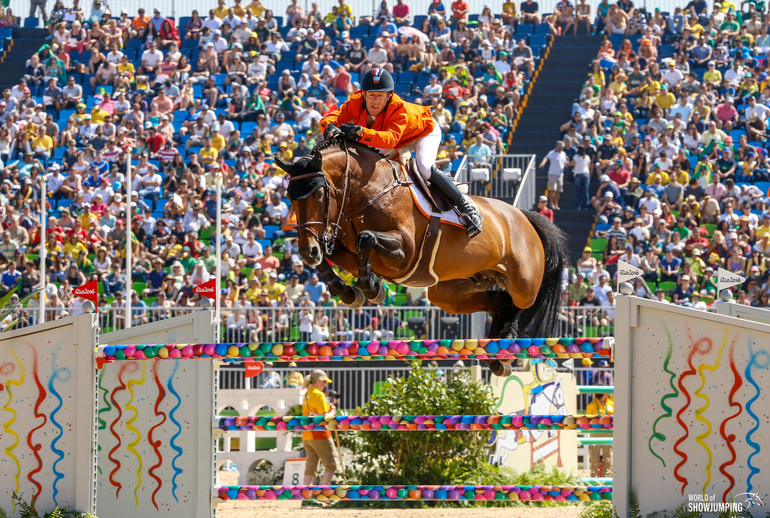Text © World of Showjumping
“Breeding and sport need each other,” Kees van den Oetelaar tells World of Showjumping. “However, that doesn’t mean that a stallion that has never jumped a Grand Prix is not a good breeding stallion. Breeding and sport are very close-knit, but on some points, they have nothing to do with one another.”
“At the moment, the biggest threat to the breeding of sport horses is that the majority wants the same; everyone is using identical bloodlines. In twenty years, we will only have ten stallions as sires to our sport horses,” van den Oetelaar says.
Breeding and top sport
Kees van den Oetelaar’s yard in Schijndel, the Netherlands, combines breeding, sport and trading – and also includes a huge riding school. Furthermore, Kees is the director and owner of the Anglo European Studbook (AES). “Our stable is in the neighbourhood of where I was born,” Kees tells. “We were a family with four children and started with a small riding school which we have developed. I think we were all born on a horse; I cannot remember a time without horses.”
You learn from travelling, as well from the mistakes you make – and I made many
Kees left school when he was 13, and the now 63-year-old has worked with horses ever since – but still refers to it all as a hobby. “I hated school,” he recalls. “Not because I was not good enough, but I only wanted to deal; in horses, cows and chickens. When I was young, I was lucky to meet some very good, old dealers, who taught me a lot and let me travel with them. I also learned a lot from my father, since my family was really into horses. I travelled all over the world to find good horses, and you learn from travelling, as well from the mistakes you make – and I made many.”
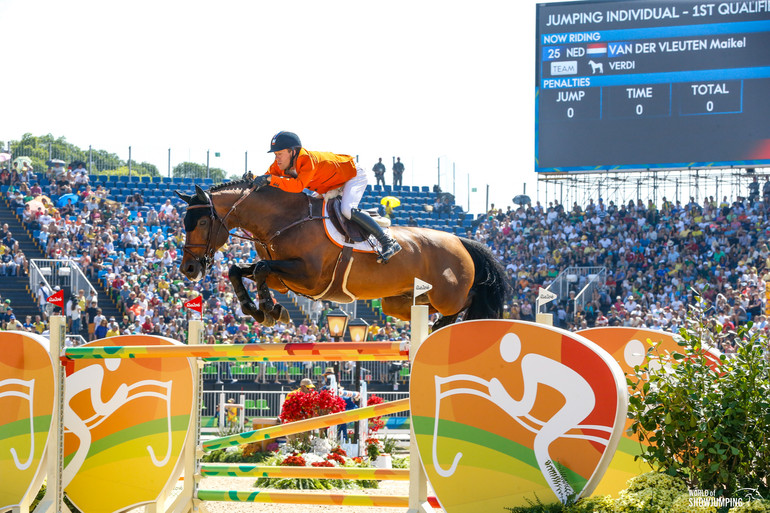 “Having a stallion that jumps on the highest level, sometimes against his offspring, is the most enjoyable thing I ever experienced with my horses and Verdi has given me that," Kees van den Oetelaar says of Verdi, that had huge success in the sport with Maikel van der Vleuten, here pictured at the 2016 Olympic Games in Rio. Photo © Jenny Abrahamsson for World of Showjumping.
“Having a stallion that jumps on the highest level, sometimes against his offspring, is the most enjoyable thing I ever experienced with my horses and Verdi has given me that," Kees van den Oetelaar says of Verdi, that had huge success in the sport with Maikel van der Vleuten, here pictured at the 2016 Olympic Games in Rio. Photo © Jenny Abrahamsson for World of Showjumping.
Today, breeding stallions – both jumping and dressage – are a huge part of the operation in Schijndel. “We are not wealthy enough to do this sport without the income from the stallions; it would be impossible for us financially to do the top sport without them,” Kees explains. “We don’t have mares at home to breed, but instead we buy foals by our own stallions from breeders that we have a long-term co-operation with. Every year, we buy around 100-150 foals and we also sell a lot.”
I like to have something that no one else has
“The main thing for us is to find good stallions, but it is very difficult to find a good sport horse that is also a good breeding stallion,” Kees continues. “What I want, is something totally different, something new, something that is not popular – I like to have something that no one else has.”
“I do sell a lot, and I try to sell as quick as possible, but there are horses that are not for sale. Over the years, I think I have had some of the best horses in the world in my hands but I have sold them – like Laura Kraut’s Cedric, Eric Lamaze’s Hickstead or Ian Millar’s In Style,” Kees tells. “But the horses that I have kept, are horses that have my heart. The first of them was Concorde, but I think the best horse ever is Verdi. I bought him as a foal, when he was two hours old and he is still ours.”
While the first stallion Kees had was Concorde (Voltaire x Marco Polo), it was Verdi TN N.O.P. (Quidam de Revel x Landgraf I) that gave him the most precious memories – while O’Bailey vh Brouwershof N.O.P. (Darco x Contact vd Heffinck) is the one that carries hope for the future. Like Verdi was, O’Bailey is ridden by Maikel van der Vleuten – and Kees’ partnership with the van der Vleuten-family began over 40 years ago. “I am in a lucky position,” Kees says. “The van der Vleuten-family has one of the best stables you can find and they are very good friends of ours. We share opinions and plans; we are most of the time on the same page.”
I simply enjoy a good horse
“Because of our relationship with the Van der Vleuten-family, we have chosen not to sell horses like O’Bailey or Verdi. I get so much joy from having them; I simply enjoy a good horse,” Kees smiles. “Having a stallion that jumps on the highest level, sometimes against his offspring, is the most enjoyable thing I ever experienced with my horses and Verdi has given me that.”
“Other people might want to have a Porsche or a swimming pool, but for me, my horses are very important. When I have a good horse and a cup of coffee, I am happy,” Kees smiles.
Horses are longer old than they are young
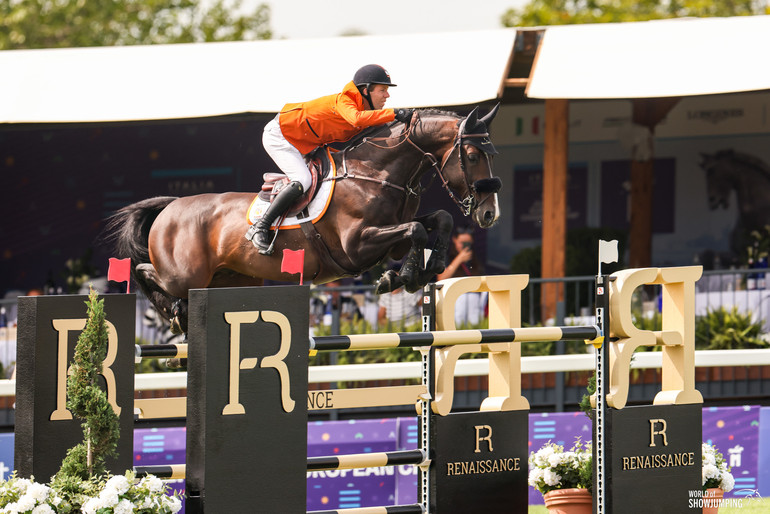 "Horses must be allowed to make mistakes and when they are ten, and still sound, only then can you start to consider if you have an international showjumper or not," Kees van den Oetelaar says – here his stallion O’Bailey vh Brouwershof N.O.P. and Maikel van der Vleuten. Photo © Jenny Abrahamsson for World of Showjumping.
"Horses must be allowed to make mistakes and when they are ten, and still sound, only then can you start to consider if you have an international showjumper or not," Kees van den Oetelaar says – here his stallion O’Bailey vh Brouwershof N.O.P. and Maikel van der Vleuten. Photo © Jenny Abrahamsson for World of Showjumping.
“When you have a young horse and you want to show other people how good a horse you have, your horse loses,” Kees says about his views on producing young horses right, with professionals you trust. “I think I have ruined some good horses by rushing them, because when I was young, I cared about what other people were thinking. You should not do things with a five-year-old that a five-year-old can’t do. Now, I know better, and I will never think like that again. Today, I think it is very important to acknowledge that when a horse is nine, it is still a baby. Horses must be allowed to make mistakes and when they are ten, and still sound, only then can you start to consider if you have an international showjumper or not. However, in my opinion, most horses are ruined before they even jump one Grand Prix.”
When you have a young horse and you want to show other people how good a horse you have, your horse loses
“The young horses today don’t have a chance to make a mistake,” Kees continues. “In the modern world we live in, with phones and videos everywhere, everybody knows in minutes if your horse has a fence down. Sometimes a rider might want to ride too well for the owners, because they want to keep the horse and make sure it jumps clear. However, this kind of mindset is not good for the horse. Unfortunately, most people want to see results – and of course results are also important – but horses are longer old than they are young. This is something I wish people understood better. It is so important to respect their age and school them correctly, with time and patience.”
Breeding today with tomorrow in mind
“I don’t think people understand how rare it is to have a good horse – it is like finding a needle in a haystack,” Kees says. “It is so complicated, and it will not get easier… In the future we will need our horses to be even more rideable because in a few years we probably cannot use spurs, nosebands, or boots – not to mention a whip. So, when breeding today, it is important to keep the future in mind – and first and foremost consider the horses’ rideability and character.”
I don’t think people understand how rare it is to have a good horse
“For example, these days it means nothing if you have a foal out of a 1.30m mare because all people look at are the heights of the courses. However, I prefer a 1.30m mare that wins a lot, over a 1.60m mare that never won; it is about the instinct of the horse,” Kees points out.
“The most important for us today should be what tomorrow holds; what will the younger generation look for? We have to think about the type of horses our children and grandchildren would want to ride. Moving forward, we need development,” Kees says.
When breeding today, it is important to keep the future in mind – and first and foremost consider the horses’ rideability and character
“We should give more young stallions opportunities in breeding and also take a look at the way we do judging,” Kees explains. “I think that currently there is a lack of stallions that do both breeding and the top sport. The young stallions don’t get enough chances and the result is that the most popular stallions are still the same as a decade or two ago. Furthermore, if we annually approve around 400 stallions for the different European studbooks, we should in my opinion see thirty of them emerge as Grand Prix horses – if the breeding was good – but currently there is maybe one or two out of those 400 that end up being exceptional. And most of the time, the one that ends up on top is the funny sort of horse; a horse that no one expected to be a good one – and that has a lot to do with the schooling. Verdi is a good example; he got the lowest points ever at his first approval, but with the education and time he got from Maikel, he turned out to be one of the very best. These days, all you seem to need is a flashy video, and you can cover hundreds of mares – even if the stallion in reality is not good.”
“In the early days, one stallion was in the north of the country, and one was in the south, and they only covered in their areas, and then after a few years they moved to another place. Now, stallions cover all over the world. Whether you go somewhere in Belgium or to Holstein in Germany, you see the same type of horses, whereas 20 years ago, I could point out a Holsteiner, a Hannoveraner, a Danish horse – you could see a difference,” Kees says. “That is all gone now. I think that is something to think about; we need new blood in our sport horses. The offspring of our horses should be better than their parents, this would mean that we did well in our breeding. Developing in this way is difficult, but there are examples of stallions who have done this – like Eldorado vd Zeshoek, who covered 25 mares in his first year of breeding and 14 of them ended up being Grand Prix horses. Then you have the crème de la crème of stallions.”
We need new blood in our sport horses
“In general, studbooks don’t co-operate enough,” Kees continues. “They are not on one line with the health of the horses. There should be one database for all studbooks, so that we have more information about our horses. For example, if I go to the stallion show at Zangersheide, I need to do X-rays, and if I go the week after with the same horse to Hannover, I need new X-rays. It would be better to do it only once, and put it in a database everyone has access to. For breeding, health data is important since a lot has to do with genetics.”
Development or deterioration?
Kees believes the current trends of auctions and progressive reproduction methods are deteriorating for both breeding and sport. “For the real breeders, all the auctions these days are a disaster,” he says. “It is only about business. I think this trend is very bad for the future, both for our breeding and for our sport. People don’t understand the prices of horses anymore: How come you can sell an embryo for 50K, but if you have a 5-year-old, it must be a performer, nice to ride and have flawless x-rays?”
People don’t understand the prices of horses anymore
“In my opinion, it would also be necessary to stop doing ICSI [Editor’s note: Intracytoplasmic sperm injection] – it should not be allowed,” Kees says. “I believe that a mare must carry her own foal, and that the two should enjoy their time together in the field. Perhaps, if you have an exceptionally good mare, there could be an opening to do one or two embryos, but not more – for me, two is the limit. We have some mares that have 20 foals in a year – and this will destroy our breeding.”
“Today, everything has to do with money, but for me, money has nothing to do with sport – or breeding,” he points out. “And the nicest aspect of breeding is that the most normal people still have the best horses. Because breeding has nothing to do with money and everything to do with feeling – and the same goes for producing young horses as well as the top sport.”
Despite all the money in it, you cannot buy yourself to anything in this sport
“And despite all the money in it, you cannot buy yourself to anything in this sport,” Kees concludes. “Because to succeed, a horse and a rider must be one; your horse must like you and you must like him. And look at the riders that win the most at the highest level today, 80-90% of them are children of farmers – who were born with the genes for this sport. I love that.”
19.12.2023 No reproduction of any of the content in this article will be accepted without a written permission, all rights reserved © World of Showjumping.com. If copyright violations occur, a penalty fee will apply.



